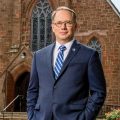The Gowanus, the BQE, the LIE, the GW, the dreaded Cross Bronx — the arteries were hardening again at the start of another week, another Monday rush hour, and also, as it turned out, another era in the annals of commuting in the New York metropolitan area. Because on this morning, Dec. 3, 1979, someone was watching the bumper-car mayhem more closely than ever before, taking its measure in a radically new way for the first time.
In a nondescript office building on Route 22 in North Jersey, a gang of kids barely out of college was busy assembling a portrait of the morning’s traffic. The wait at the tunnels was how long? An accident had closed a lane on what expressway? What bridge was backed up the farthest?
News flowed into the new Shadow Traffic headquarters in Union Township from all around the region. There were airplanes circling above the usual chaos, mobile units dodging along the same roads as commuters, producers calling police and transit officials, and some field reporters — known as “Kongs” in honor of the heights they had scaled — standing atop the Empire State Building and the World Trade Center, hoping the clouds didn’t drop too low.
Seven reporters were sealed away in the boxy little studios that ringed the headquarters’ main operations desk, reading into their microphones minute-long traffic reports that were fed to dozens of radio stations. Four of them were from Seton Hall: Joe Nolan, Bernie Wagenblast, George W. Forman and Donna Fiducia.
“It wasn’t high-tech at all, but it was very high-tech looking — lots of flashing lights, guys with headsets talking in two-way radios, a lot of things that looked very cool,” said Nolan, whose studio had its own low-tech tool: a window that meant he didn’t have to rely on anyone else to tell him what was happening on Route 22. “It was earth-shattering back then to have one person be on multiple stations at the same time — it was unheard of.”
That day, Shadow Traffic — which had debuted earlier in Philadelphia and Chicago — changed the drive-time habits of millions of commuters in New York, New Jersey and Connecticut. Before Shadow, only a handful of radio stations broadcast anything more than the most rudimentary information about what was happening out on the highways each morning. After Shadow, even the smallest stations did. Traffic woes still plagued the metropolitan region each rush hour, and while the Shadow reporters couldn’t cure the affliction, they were able to diagnose it more precisely.
And in those first years of Shadow, the majority of its voices were trained at a single college station, WSOU. “The first time that I was talking on the radio and being paid for it was on WYNY, which was at that time NBC-owned and broadcasting from the ninth floor of 30 Rock,” said Forman, who had graduated just a few months earlier, and whose Shadow handle was “G.W.,” so no bleary drivers would think the former heavyweight champion was giving traffic updates. WYNY was the biggest of the stations his reports were broadcast on each day.
Wagenblast had graduated in 1978, and now he was bantering on WABC with legendary Top 40 DJ Dan Ingram. “This was the big time,” he said, describing his nerves on that inaugural morning. “We were going to be on New York radio, and we were going to be on New York radio in drive time.”
None of them were old enough yet to truly understand the dispiriting implications of a jackknifed tractor-trailer on the Turnpike, but they quickly became the voices of authority to drivers trying to find the clearest passage between home and work.
“When we got to the last traffic report of that morning rush hour it was like, ‘Oh my gosh, we did it. It came off and there were no major goofs and everything worked, and can you believe it, it was a success,’” said Wagenblast, whose previous commuting experience had consisted mainly of driving his Chevy Nova from his Cranford home to the campus whose radio station had beckoned him since he was a boy.
WSOU was an early occupant of the FM band, staking out a wide listening area from the time it began broadcasting from the basement of the University’s recreation center in 1948. It was a beacon, too, to many New Jersey kids who had dreams of spinning Beatles records on the air, or calling a basketball game, or reporting the latest news.
“I knew I wanted to be in radio from when I was in elementary school,” Wagenblast said. WNEW-AM was his station. William B. Williams, Klavan and Finch, Ted Brown — they were who he wanted to be, and Seton Hall, he reasoned, was his best route there. “WSOU was the unique combination in the tri-state area of both being run by the undergraduate students and having a wide coverage area.”
He signed up at the station as soon as he arrived on campus for freshman orientation. Within a few months he had his air clearance, granted by an upperclassman who would later become a colleague at Shadow, Pete Tauriello.
“I did my homework long before I got to Seton Hall,” said Tauriello ’76, who was first nudged toward the university by his fifth-grade teacher in Old Bridge, a Seton Hall man whose class ring seemed such a precious treasure. “I knew all about WSOU. I could tell you what kind of transmitter they had by the time I was in eighth grade.”
Tauriello got his first microphone when he was 5, and his boyhood bathrobe was imprinted with a pattern of TV cameras and mics. In high school he broadcast a show each morning through the public-address system. He worked as program director for WERA in Plainfield before joining his former WSOU colleagues on Shadow Traffic in 1982. “It was the Seton Hall mafia,” Tauriello said about Shadow.
George Forman had his own epiphany in seventh grade, when he visited the Ocean County Fair with his grandparents and was enthralled by the two radio stations that had set up remote broadcasts there: WJLK and WOBM. He joined WSOU his first week on campus and by November he was hosting “Take it Easy,” a midday show that played music tagged with an adjective much employed in the 1970s: mellow. He still remembers his first set: The Rolling Stones’ “As Tears Go By,” the Beatles’ “She’s Leaving Home,” and Emerson Lake and Palmer’s “Still You Turn Me On.”
“I even found a mellow Jerry Lee Lewis record,” he said.
Joe Nolan and Donna Fiducia came to Seton Hall with different career ambitions, each expecting it to be a prelude to law school. WSOU lured them down another path.
“WSOU really taught you the basics,” said Fiducia ’79, who also hosted “Take It Easy.” “That station, no matter what happened, never went off the air. You stayed there until the next person came on the air. The show went on. Everybody had to know how to do everything else, no matter what their interest was.”
Nolan was a big basketball fan, and he was soon broadcasting Pirates games. “People hear you,” said Joe Nolan, whose grandfather was police chief in Jersey City, and whose father was a St. Peter’s grad not too thrilled that his son was headed to his alma mater’s basketball archrival. “It’s not like so many college radio stations around the country where you’re heard in the cafeteria and the parking lot. You can hear WSOU all over New Jersey.”
He covered news, too, and managed to get onto the White House lawn when President Jimmy Carter presided over the famous handshake between Menachem Begin and Anwar Sadat. When Pope John Paul II made his first trip to the United States in the fall of 1979, the loyal Polish listeners of Cousin Stan Kosakowski’s Polka Party show on WSOU sent enough donations to pay for Nolan to follow the first Polish pope. A team of eight student reporters stationed themselves along the route of the pope’s ticker-tape parade in Manhattan.
“We sat on top of the phone booths and the cops came along, and we said, ’We’re from Seton Hall’s radio station, we’re doing a live report.’ They’re mostly Irish-Catholic cops and they hear Seton Hall — ‘OK, fine, go ahead, do what you want,’ ” Nolan said. “I might have been imagining this, but I remember he’s coming down Broadway and he looks over and sees me with the phone up to my ear sitting on top of the phone booth, and to this day, I am certain he looked me dead in the eye and he had this look on his face like, ‘What is that kid doing?’ ”
Nolan traveled to Washington, D.C., too, for the pope’s final stop. “I remember walking back to the hotel and it was getting dark and I had lost my train ticket,” he said.
“I thought I was dead, I had lost Cousin Stan’s train ticket, and I remember just blessing myself and saying a little prayer and I remember saying, ‘John Paul the Second, please pray for me,’ and I walked back to the hotel and sure enough within 30 seconds I found that train ticket.”
Soon after he came home, he got the call to audition for Shadow while still a junior at Seton Hall. “Fred Feldman hired me,” he said, referring to the veteran helicopter reporter who ran Shadow’s traffic operations, “and the rest is history, all because of the pope, and Cousin Stan.”
When Shadow was hiring its first traffic reporters — a job category that had barely existed before — WSOU alumni were a natural target: young, plentiful and technically skilled beyond their years.
“It was the opportunity of a lifetime — none of us knew it at the time, but it really was,” Nolan said. “You were out there working on big-time radio stations. We were all 21, 22, 23. The bosses were 24. It wasn’t like you were walking into a corporate environment at all. You were walking into basically what you had been doing the whole time at Seton Hall.”
They worked a split shift: 6 a.m. to 9:15 a.m. for the morning rush hour, then back again from 3:30 p.m. to 7 p.m. as the tide reversed. “It was almost like an extension of college,” Fiducia said. “All our friends were there. We were young. It was a lot of fun to do, and we were getting paid for what we wanted to do.”
And after the last report on Friday nights, they made their own brief commute, to a restaurant called Beggars Banquet in Union. “Fred Feldman used to say, ‘You guys are like a fighter squadron after a mission,’ ” Nolan said. “We were all single, we were all basically still college kids and we had our own money for the first time in our lives.”
Nolan is still getting up long before dawn, and driving into the WABC-TV studios in Manhattan to give traffic updates every seven minutes. Pete Tauriello is the traffic voice on 1010 WINS every weekday morning, broadcasting from the Rutherford studios of the company now known as Metro/Shadow Traffic. George Forman is a weekend DJ on WOBM in Toms River, and works for a company that produces DVDs. Donna Fiducia has worked just about everywhere, on both TV and radio, from Howard Stern to WNEW to Fox News. She now raises horses on a farm in Georgia.
“I could hold down the fort for two hours,” she said about her stints hosting television broadcasts when news was breaking, like the death of Princess Diana. “I attribute that to radio, because radio is so spontaneous – nothing is scripted. You’re not just reading a teleprompter. You have to be able to ad lib and you have to be informative and you have to sound good, and I really think that does go back to WSOU, because that really was a great training ground.”
Bernie Wagenblast is back on WINS part-time after a long series of transportation-related jobs, and he edits several transportation newsletters. His is also the voice you hear in the airport trains at Newark and JFK. And the best commuting tip he has for anyone headed to his alma mater — where the biggest problem usually isn’t getting there, but finding a place to park once you do — is to do what he always did: wake up early, and be there first.
“It’s a recurring theme,” he said. “Getting there early and beating the crowds.”
Kevin Coyne is a New Jersey writer who teaches at Columbia University’s Graduate School of Journalism.







